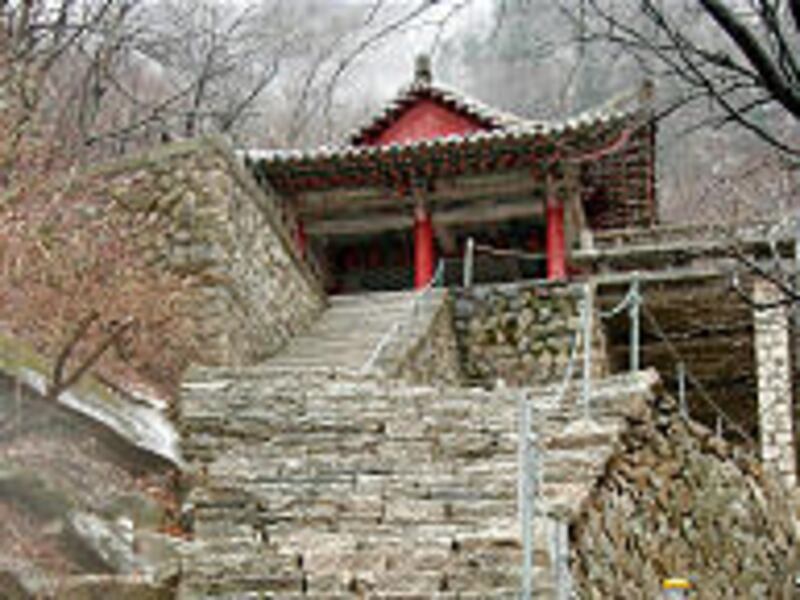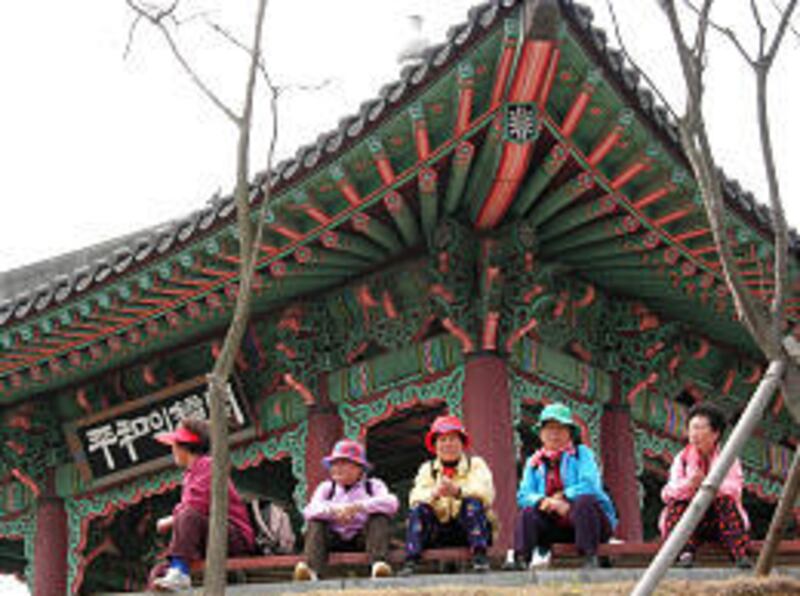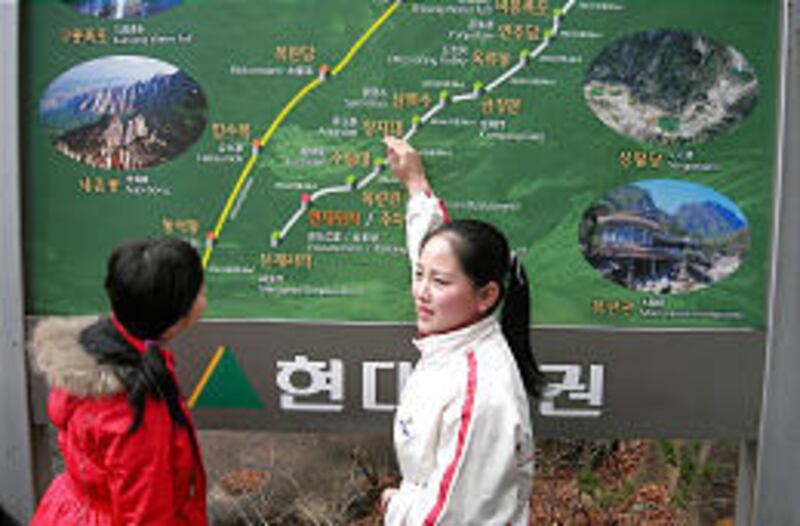MOUNT KUMGANG, North Korea — There is nothing in the peaceful splendor of Mount Kumgang to suggest it is part of a country that President Bush called an axis of evil.
Angular rocks jut heavenward, forming craggy spines on its granite peaks. Legend has it that animals that once roamed the forest turned to stone because it was too beautiful to leave. Crystal-clear streams spill into emerald pools and cascade over sheer cliffs.
Hikers — mostly middle-aged South Korean couples wearing colorful sweat suits and hiking boots — traverse pine- and maple-lined trails looking for the spiritual renewal Kumgang is said to offer. Some sip from a cool spring touted as a fountain of youth.
Mount Kumgang (Diamond) sits about equidistant from Pyongyang and Seoul, the capitals of North Korea and South Korea, respectively. But it is far removed from the often tense political push-pull of two nations technically still at war.
It is one of two main North-South cooperative projects, initiated not by the countries' communist and democratic governments but by private enterprise. It also is a place where Westerners can travel into the closed country without too much trouble.
Hyundai Asan, an arm of South Korean shipbuilding and car-making giant Hyundai, paid the North Korean government $1 billion for exclusive rights to develop a Western-style resort at the base of the mountain. (The payment also included the right to build a manufacturing complex on the other side of the country, where South Korean companies employ North Korean workers.)
"We started our business for inter-Korean cooperation and peace in the Korean peninsula," said Byun Ha Jung, Hyundai Asan general manager for planning and foreign investor relations.
Since 1998, the company has pumped more than $400 million into the resort, which currently includes three hotels, two condominium villages, four North Korean and six South Korean restaurants, two souvenir shops and a performing arts center featuring North Korean acrobats. An 18-hole golf course is set to open in the fall.
A peculiar capitalism is alive and well here. U.S. dollars are the preferred currency.
A two-night, three-day stay runs about $400, of which $80 goes to the North Korean government. To date, the company has paid out $114 million based on its overnight packages.
U.S. Assistant Secretary of State Christopher Hill has said the resort exists to funnel money to the communist regime, which tested a nuclear bomb last October. But Byun said Hyundai Asan is confident the money has gone to help revitalize the collapsed North Korean economy.
Hyundai Asan has yet to profit from the venture. But what the company has done, Byun said, is open the gate for reconciliation on the Korean peninsula. When relations sour, the company remains a channel of communication.
"This trust will strongly affect the Korean reunification," he said.
That trust, however, is a fickle thing. A railway connecting the two countries remains idle. Hyundai Asan's new station on the South Korean side is ghostly quiet. Byun said the North Korean government inexplicably pulled the plug just before the first train was set to roll. But just last month, the North allowed a one-time symbolic running of the train, marking the first time the tracks were used since the Korean War.
"We have arguments with North Korea, but we are still friends," he said.
So far, about 1.5 million people have visited the resort at Mount Kumgang since it opened in 1998. All but about 10,000 were South Koreans. The others represent 48 countries but have been largely Korean-Americans.
South Korean tourist Im Yong Sik from the industrial city of Ulsan recalled singing songs about Mount Kumgang as a schoolboy and has long wanted to visit. He said the venture is good for the peninsula, and he hopes reunification will soon be a reality.
Reunification facilitated by the Red Cross has occurred on a much smaller scale at the resort. Mount Kumgang has become ground zero for reuniting families separated during the Korean War. Special accommodations for them are set to open next year.
Though it employs hundreds of North Koreans, the resort does not cater to their countrymen. They have their own way to the mountain.
Our half-day hike on a drizzly morning took us to Kuryong (Nine Dragons) Falls, a 244-foot-long column of water flowing down a smooth rock wall. According to legend, nine dragons gathered here to defend Mount Kumgang.
Young women in red mountain gear and rain ponchos posted at tables along the trail sell fruit drinks, Asian pears, nuts and candy. Young men in blue jackets walk the path as members of a mountain rescue team. All sport pins showing revered former dictator Kim Il Sung, not because they have to, they say, but because they want to.
Talking with a North Korean is a rare opportunity and part of the Kumgang experience. Hand-picked for their jobs, they greet visitors with polite smiles and have likely been briefed on how to respond to sensitive political topics.
Though they are described as generally naive, emotional and ignorant of foreign affairs, that isn't necessarily true. They had little trouble (through an interpreter) discussing world events like the six-nation nuclear talks or the Iraq war.
"We don't think all Americans are bad," one young woman said. "We don't like the American government."
At one point, we asked a young man if he thought the United States would attack North Korea. He explained that while America is so big and North Korea is so small, the only reason it doesn't attack is because current dictator Kim Jong Il is such a great and powerful leader.
Small talk and personal questions, however, seemed to puzzle them. They found questions about how much they earn and how they live irrelevant.
One young woman told me she was happy and satisfied with her life as we walked down the trail at the end of the day. She gave me a handful of candy before we parted.
Visitors, who are bused in daily, are not allowed to leave the confines of the resort area, except for the hiking trails. Tour buses are restricted to the "Tourist Road" built by Hyundai Asan.
Shabby-looking North Korean villages just beyond the fenced perimeter where farmers tend to rice and other crops are off limits. Signs warn visitors to refrain from taking photos outside the tightly controlled environment. North Korean soldiers scan the landscape from guard shacks and platforms.
All the restrictions and politics aside, the scenery at North Korea's most treasured natural attraction rivals that of any national park in the United States.
There are six different hiking routes, or courses, as the Koreans call them, ranging in distance from 5 kilometers (3.1 miles) to 15 kilometers (9.3 miles) round trip. Tree-lined trails lead to mountain peaks, picturesque waterfalls and the gentle shore of the Sea of Japan. Hikers may encounter rock carvings, Buddhist temples and walking bridges.
For relaxation after a day on the mountain, the resort offers a hot springs spa, Chinese massage, a North Korean acrobatic show and North Korean folk music.
North Korean products like traditional wines, ginseng tea and pine pollen honey sit alongside designer jewelry and cosmetics in the South Korean duty-free shops.
There is another North-South joint effort worth visiting at Mount Kumgang, unusual because it involves religion.
South Korean monks, with some North Korean labor, are rebuilding a Buddhist temple destroyed by U.S. warplanes in 1951. An 85-year-old female monk, the last survivor of the bombing, is among those living there. Temples on the site date back to 519.
The main shrine at Shingyesa is complete, while the housing quarters are scheduled to be finished this year. Due to ideological differences, North Korea might not allow the monks to occupy it permanently. The communist regime has long been hostile toward houses of worship.
On the Net:
Web sites: www.hyundai-asan.com (English version available); www.mtkumgang.com
E-mail: romboy@desnews.com












